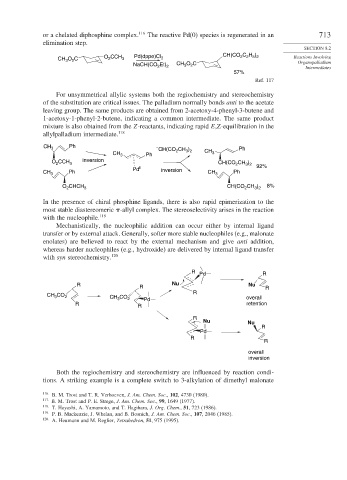Page 737 - Advanced Organic Chemistry Part B - Reactions & Synthesis
P. 737
or a chelated diphosphine complex. 116 The reactive Pd(0) species is regenerated in an 713
elimination step.
SECTION 8.2
2 2 5 2
2
CH O C O CCH 3 Pd(dppe)Cl 2 CH(CO C H ) Reactions Involving
2
3
NaCH(CO Et) CH O C Organopalladium
2
3
2
2
Intermediates
57%
Ref. 117
For unsymmetrical allylic systems both the regiochemistry and stereochemistry
of the substitution are critical issues. The palladium normally bonds anti to the acetate
leaving group. The same products are obtained from 2-acetoxy-4-phenyl-3-butene and
1-acetoxy-1-phenyl-2-butene, indicating a common intermediate. The same product
mixture is also obtained from the Z-reactants, indicating rapid E,Z-equilibration in the
allylpalladium intermediate. 118
Ph
CH 3 –
CH(CO CH ) Ph
CH 3 Ph 2 3 2 CH 3
O CCH 3 inversion CH(CO CH )
2
2
3 2
Pd II inversion 92%
CH 3 Ph CH 3 Ph
O CHCH 3 CH(CO CH ) 8%
2
3 2
2
In the presence of chiral phosphine ligands, there is also rapid epimerization to the
most stable diastereomeric -allyl complex. The stereoselectivity arises in the reaction
with the nucleophile. 119
Mechanistically, the nucleophilic addition can occur either by internal ligand
transfer or by external attack. Generally, softer more stable nucleophiles (e.g., malonate
enolates) are believed to react by the external mechanism and give anti addition,
whereas harder nucleophiles (e.g., hydroxide) are delivered by internal ligand transfer
with syn stereochemistry. 120
R
Pd R
R R Nu Nu R
R
CO
CH 3 2 CH 3 CO 2 Pd overall
R R retention
R
Nu Nu
R
Pd
R
R
overall
inversion
Both the regiochemistry and stereochemistry are influenced by reaction condi-
tions. A striking example is a complete switch to 3-alkylation of dimethyl malonate
116 B. M. Trost and T. R. Verhoeven, J. Am. Chem. Soc., 102, 4730 (1980).
117
B. M. Trost and P. E. Strege, J. Am. Chem. Soc., 99, 1649 (1977).
118
T. Hayashi, A. Yamamoto, and T. Hagihara, J. Org. Chem., 51, 723 (1986).
119 P. B. Mackenzie, J. Whelan, and B. Bosnich, J. Am. Chem. Soc., 107, 2046 (1985).
120
A. Heumann and M. Reglier, Tetrahedron, 51, 975 (1995).

